Introduction:
Safety in the workplace is paramount for the well-being of employees and the success of any organization. One of the key aspects of maintaining a safe working environment is effective safety communication. Having open and honest safety conversations can prevent accidents, reduce injuries, and foster a safety culture among employees. In this article, we will explore ten highly effective safety conversation techniques that can make a significant difference in your workplace.
The significance of open and effective safety conversation in promoting safety
Open and effective conversation holds immense significance in promoting safety. Open and effective conversation is essential in promoting safety as it enables hazard identification, empowers individuals with knowledge, fosters a safety-conscious culture, and facilitates continuous improvement. It establishes trust, enhances teamwork, and ultimately contributes to creating a safer and more secure environment for everyone involved. Let’s explore the key aspects of its importance:
1. Rapid Hazard Identification and Reporting: When communication channels are open, individuals are more likely to voice their observations about potential hazards or unsafe conditions promptly. This enables quick identification and reporting of safety risks, allowing for timely interventions to prevent accidents and injuries.
2. Prompt Incident and Near-Miss Reporting: An environment that encourages open conversation facilitates the reporting of incidents and near-miss events without fear of reprisal. Timely reporting provides invaluable data for root cause analysis, leading to effective preventive measures.
3. Creating a Safety Culture: Open communication is fundamental to establishing a robust safety culture within an organization or community. It fosters an atmosphere where safety is valued, and individuals feel comfortable discussing safety-related matters.
4. Enhanced Safety Knowledge Sharing: Effective conversations enable the exchange of safety-related information, best practices, and lessons learned. This sharing of knowledge empowers individuals with the information they need to make safe decisions and take appropriate actions.
5. Identifying and Addressing Safety Gaps: Through open conversations, individuals can freely express concerns or challenges related to safety procedures, equipment, or training. This allows organizations to identify and address safety gaps effectively.
6. Supporting Collaboration and Teamwork: Open communication promotes collaboration among team members, allowing them to work together in implementing safety protocols and achieving common safety goals.
7. Transparent Safety Policies and Procedures: When communication is transparent, safety policies and procedures become clear and understandable to all. This clarity ensures consistent adherence to safety guidelines.
8. Boosting Employee Engagement: A culture of open conversation enhances employee engagement in safety initiatives. Employees feel valued when their input is sought, and they are more likely to participate actively in safety programs.
9. Feedback and Continuous Improvement: Open communication channels facilitate feedback loops where safety concerns and suggestions can be freely shared. This feedback supports continuous improvement efforts in safety management.
10. Instilling Trust and Psychological Safety: In an environment of open communication, individuals feel psychologically safe, knowing they can speak up about safety issues without fear of blame or judgment. Trust among team members and between employees and management is also strengthened.
11. Preventing Catastrophic Incidents: Open and effective conversation aids in preventing major accidents or disasters. By openly discussing potential risks and vulnerabilities, proactive measures can be taken to avoid catastrophic events.
12. Compliance and Regulation Adherence: Open communication ensures that safety-related information, updates, and regulations are effectively communicated to all relevant parties, promoting compliance and adherence to safety standards.
What are the Golden Rules of Effective Safety Conversations?
The Golden Rules of Effective Safety Conversations are essential guidelines to ensure that safety discussions are productive, and constructive and result in positive outcomes. Following these rules fosters a culture of safety, encourages open communication, and promotes continuous improvement.
Safety conversations are an essential part of any workplace safety culture. They help to build trust, identify hazards, share best practices, and reinforce positive behaviors. However, not all safety conversations are equally effective. Some may be too superficial, too confrontational, or too passive. To ensure that your safety conversations are meaningful and impactful, you need to follow some golden rules.
Here are the Golden Rules of Effective Safety Conversations:
– Prepare before you speak: Before you initiate a safety conversation, think about your purpose, your audience, and your message. What do you want to achieve? Who are you talking to? What do you want to say? How will you say it? Having a clear plan will help you to communicate more confidently and effectively.
– Listen actively and empathetically: A safety conversation is not a one-way lecture. It is a dialogue that requires listening as much as speaking. Listen to what the other person is saying, how they are saying it, and what they are feeling. Show that you care about their perspective and their emotions. Ask open-ended questions, paraphrase what they say, and give feedback.
– Focus on facts and behaviors, not opinions and personalities: A safety conversation is not an opportunity to criticize, blame, or judge the other person. It is a chance to share facts and observations, and to discuss behaviors and actions. Avoid making assumptions or generalizations about the other person’s motives or intentions. Use specific examples and evidence to support your points.
– Be positive and constructive: A safety conversation is not a punishment or a threat. It is a way to encourage and support the other person to improve their safety performance and attitude. Use positive language and tone, and acknowledge the good things they do as well as the areas they need to work on. Provide constructive feedback and suggestions, and offer help and resources if needed. – Follow up and follow through. A safety conversation is not a one-time event. It is a part of an ongoing process of safety improvement and learning. After the conversation, make sure to follow up with the other person to see how they are doing, and to provide additional feedback or assistance if necessary. Also, follow through on any commitments or actions that you agreed on during the conversation.
– Keep the number of rules to as few as possible: Too many rules can be confusing, overwhelming, or contradictory.
– Allow for some flexibility and the reality of human fallibility: Do not expect perfection or punish honest mistakes, but rather encourage learning and improvement.
– Make them personal, such as “I will not” rather than “Do not”: This can help create a sense of ownership and responsibility for safety.
– Consult, communicate, communicate, communicate, educate, and ensure all understand: Effective safety conversations require active listening, clear speech, mutual respect, and feedback.
– They must be very relevant to the actual workplace: The rules should address the specific hazards, risks, and behaviors that can cause serious harm in your work environment.
– They should cover high risks and situations or behaviors that can cause serious harm. The rules should focus on the most critical and preventable causes of injury or illness.
1. Active Listening: The Foundation of Effective Safety Conversations
Active listening is the cornerstone of any successful safety conversation. When employees feel heard and valued, they are more likely to speak up about potential hazards or safety concerns. During safety discussions, give your full attention to the speaker, maintain eye contact, and avoid interrupting. Encourage employees to express their thoughts, ideas, and even fears related to safety. Avoid assigning blame or judgment during safety conversations. Focus on understanding the underlying causes of safety issues or concerns and finding solutions collaboratively. Remember, safety is a collaborative effort, and active listening ensures that everyone’s voice is heard.
2. Safety Training: Empowering Employees with Knowledge
Knowledge is power, especially when it comes to safety. Conduct regular safety training sessions to educate employees about potential risks, safe practices, and emergency procedures. Ensure that all employees are well-informed about safety protocols and the proper use of safety equipment. Informed employees are more confident and proactive when discussing safety matters. A well-informed discourse equips individuals with the necessary tools and insights to make informed decisions regarding safety protocols and procedures. Communicate safety information in straightforward, jargon-free language to ensure everyone understands the risks and preventive measures.
3. Empathy and Emotional Intelligence: Supporting Employees’ Safety Concerns
Demonstrate empathy and understanding when discussing safety concerns with employees. Acknowledge their feelings and experiences, and assure them that their well-being is a top priority. Practitioners with high emotional intelligence can recognize their own emotions and manage them appropriately during discussions, enabling them to remain composed and focused on the safety concerns at hand. This fosters trust and strengthens the safety culture within the organization.
4. Use Real-Life Examples: Making Safety Conversations Relatable
Incorporate real-life examples and case studies into safety conversations. These examples make safety risks and their potential consequences more tangible, driving home the importance of adhering to safety protocols. Share success stories where safety practices have prevented accidents, reinforcing the positive impact of safety measures.
5. Encourage Reporting: Creating a Reporting-Friendly Environment
Employees may hesitate to report safety issues due to fear of repercussions or the belief that their concerns won’t be taken seriously. Establish a confidential reporting system where employees can report safety concerns without fear of retaliation. Create a reporting-friendly environment where employees are encouraged to report even minor safety incidents or near-misses. Assure them that reporting is a crucial step towards improving safety and that their feedback is valued.
6. Leading by Example: Management’s Role in Safety Conversations
As a manager or supervisor, your actions speak louder than words. Leading by example demonstrates your commitment to safety. Engage in safety conversations with your team regularly and share your own experiences and concerns. This will encourage open communication and reinforce the message that safety is a top priority for the entire organization.
7. Solutions-Oriented Approach
Focus on finding practical solutions to safety challenges rather than dwelling on problems. Collaborate with others to develop actionable plans to improve safety.
8. Consistency and Regularity
Make safety conversations a regular part of the work routine. Consistent engagement reinforces the importance of safety and fosters a culture of continuous improvement.
9. Using Visual Aids: Enhancing Safety Communication
Visual aids, such as infographics, charts, and posters, are powerful tools for enhancing safety communication. They can simplify complex safety information and reinforce key safety messages. Use visual aids strategically during safety training sessions and workplace communication to make safety information more accessible and memorable. Record key points and actions discussed during safety conversations. Ensure follow-up on agreed-upon solutions and track progress towards safety goals.
10. Addressing Safety Misconceptions: Debunking Myths
Safety misconceptions can undermine efforts to create a safe workplace. Address common safety myths and misconceptions during safety conversations. Provide factual information and evidence to debunk these misconceptions and establish a solid foundation for safety practices.
11. Positive Reinforcement: Acknowledging Safe Behavior
Positive reinforcement goes a long way in promoting safe behavior. Recognize and praise employees who adhere to safety guidelines and actively contribute to safety conversations. This fosters a sense of accomplishment and encourages others to follow suit. Recognize and celebrate safety achievements, both big and small. Positive reinforcement encourages individuals and teams to maintain their commitment to safety. Treat safety conversations as opportunities for learning and growth. Stay open to new ideas, feedback, and industry best practices to enhance safety processes continually.
12. Constructive Feedback: Provide feedback in a constructive manner, emphasizing positive aspects and areas for improvement. Avoid being overly critical or negative, as it may deter individuals from engaging in future safety conversations.
By following these golden rules, you can make your safety conversations more effective and beneficial for yourself and the other person. Remember that safety conversations are not only about preventing accidents and injuries, but also about building relationships and trust, fostering a positive safety culture, and enhancing performance and productivity.
Safety conversations should not be static; they should evolve with changing circumstances and needs. Continuously seek feedback from employees about safety protocols and communication techniques. Use this feedback to improve safety conversations and keep them relevant and effective.
Different Types of Safety Conversations
Deliberate Mandatory Safety Conversation
1. Deliberate Mandatory Safety Conversation
1.1 Observation Based Conversation
i. Conducting Thorough Safety Inspections and Audits
ii. Identifying Potential Hazards and Risks
iii. Strategies for Effective Risk Control
1.2 Morning Safety Conversation
i. Promoting Daily Safety Awareness
ii. Reinforcing Safe Work Practices
iii. Addressing Potential Hazards for the Day
1.3 Task-Specific Safety Conversations
i. Integrating Safety into Job Requirements
ii. Task-Specific Safety Precautions
iii. Ensuring Competence for the Job
1.4 Hazard Identification and Risk Control Conversation
i. Proactive Approach to Hazard Recognition
ii. Evaluating and Prioritizing Risks
iii. Implementing Effective Controls
1.5 Safety Target Setting Conversation
i. Defining Clear Safety Objectives
ii. Monitoring Progress Towards Targets
iii. Strategies for Achieving Safety Goals
2. Spontaneous Safety Conversation
2.1 Addressing Unsafe Acts in Real-time
i. Encouraging a Speak-Up Culture
ii. Providing Constructive Feedback
iii. Correcting Unsafe Behaviors Immediately
2.2 Opportunity-Based Safety Conversation
i. Grabbing Appropriate Moments for Safety Discussions
ii. Sharing Safety Ideas and Suggestions
iii. Encouraging Continuous Improvements
iv. Innovative ideas discussion
2.3 Trending Safety News Conversation
i. Analyzing Recent Safety Incidents and Trends
ii. Drawing Lessons from Industry Examples
iii. Applying Best Practices to Enhance Safety
3. Safety Conversation in Meetings
3.1 Management Reviews
i. Discussing Safety Statistics and Performance in Meetings
ii. Share Top Safety Issues and Obtain Executives’ Directions
iii. Compare Safety with Overall Organizational Objectives
3.2 Team Performance Meetings
i. Empowering Safety Teams to Drive Change
ii. Collaborative Problem-Solving for Safety Challenges
iii. Celebrating Safety Milestones and Achievements
4. Accident Investigation Conversation
i. Discuss Root Cause Analysis
ii. Learning from Mistakes and Preventing Recurrence
iii. Promoting a Non-Blame Culture for Transparent Reporting
5. External Safety Conversations
i. Engaging with Safety Experts and Consultants
ii. Learning from Industry Peers and Best Practices
iii. Collaborating with External Stakeholders for Safety Improvement
Safety Conversation Example: A dialogue between a worker and a safety professional
Safety Officer (SO): (Noticing the worker’s non-compliance) I must address the issue of not wearing a safety helmet earlier. It is a breach of safety regulations, and we take these matters seriously.
Worker (W): (Defensively) Come on, nothing happened! Why are you making such a big deal out of it? I’m perfectly fine, and nothing will happen. I have more experience than you, and I know what I’m doing.
SO: I understand that you may feel experienced and confident, but safety protocols are in place for a reason. Accidents can happen at any time, regardless of experience. The risk of not wearing a safety helmet, even for a brief moment, is just too high to ignore.
W: (Resistant) I’ve been doing this job for years without any issues. Why are you singling me out for a fine?
SO: It’s not about singling anyone out. As a safety professional, my duty is to ensure that safety rules are followed consistently by everyone. It’s about fostering a culture of safety for the well-being of all workers, including you.
W: (Frustrated) I have so much work pressure, and now you’re here, stopping me from getting my tasks done. Can’t you see I need to keep working?
SO: (Calmly) I understand that you have work pressure, and I value your dedication. However, safety is our top priority, and “Safety First” is our guiding principle. I’m here not to stop your work but to ensure that it’s done safely and without compromising anyone’s well-being.
W: (Skeptical) But how does wearing a safety helmet or following safety procedures change anything? I’ve been working like this for years, and nothing has happened.
SO: (Assuringly) Safety precautions may seem small, but they can make a significant difference. Accidents can occur unexpectedly, and safety measures are designed to prevent or minimize their impact. Wearing a safety helmet, for instance, protects you from potential head injuries, even during routine tasks.
W: (Resistant) I’ve never had any accidents, and I know what I’m doing. You don’t have to babysit me.
SO: (Respectful) I don’t doubt your competence, and I’m not here to babysit anyone. My role is to ensure that all workers, including you, return home safely to your families every day. Accidents can happen to anyone, regardless of experience. Following safety procedures is about safeguarding lives and preventing injuries.
W: (Defensively) I know it’s mandatory, but it’s just so hot and uncomfortable. I took it off for a while to get some relief.
SO: I understand it can be uncomfortable, especially in the heat. But your safety is of utmost importance to us. Instead of taking it off, you can take short breaks and go to the rest area to cool down. You can always come back to work once you feel better.
W: (Reluctant) It’s just that sometimes these safety measures slow down my work.
SO: (Understanding) I hear your concern, and it’s essential to maintain productivity. However, let’s remember that even a small delay due to safety precautions is a small price to pay compared to the potential consequences of an accident. Moreover, over time, safety practices become second nature and won’t impede your efficiency significantly.
W: (Softening) Alright, I’ll give it a try, but can you help me with the safety helmet? I find it uncomfortable. (Wiping sweat from his forehead) Ah, it’s so hot today! I couldn’t bear wearing that heavy and uncomfortable safety helmet for too long.
SO: (Supportive) Of course! Let’s find a safety helmet that fits comfortably and meets the required safety standards. Your comfort matters, and I’m here to assist you in any way I can.
W: (Still hesitant) It’s not just about the heat; it’s heavy and feels burdensome.
SO: I hear you. The safety helmet might seem heavy sometimes, but I assure you it’s a small price to pay for your safety. Let me share a story with you. Last month, there was a near miss at our worksite. A tool fell from a higher level, and it narrowly missed a worker’s head. Luckily, he was wearing his safety helmet, and that helmet saved his life.
W: (Listening more attentively) Really? A helmet saved someone’s life here?
SO: Yes, it did. That incident reminded us of the importance of wearing safety helmets at all times. It’s not just about following the rules; it’s about safeguarding your life and preventing serious injuries.
W: (Reflecting) I never thought about it that way. But it’s still uncomfortable.
SO: I understand, and I appreciate your concerns. Let’s explore some solutions together. We can look into finding a more comfortable and lightweight safety helmet that meets the required safety standards. Your comfort matters to us, but so does your safety.
W: (Reluctant) I just don’t think I deserve a fine for this.
SO: (Empathetic) I understand that fines can be frustrating, but they serve as a reminder to prioritize safety and adhere to regulations. We want to prevent incidents and protect everyone on the worksite.
W: (Thoughtful pause) I suppose I can see your point. Safety is crucial, and I shouldn’t take any risks.
SP: (Encouraging) That’s the right mindset. Your safety and that of your colleagues are our top priorities. It’s about looking out for each other and ensuring we all return home safely every day.
W: (Reflective) I never thought about it that way. I’ll be more mindful from now on.
SO: (Supportive) That’s great to hear. If you have any concerns or need assistance with safety gear, don’t hesitate to ask. We’re all in this together, and I’m here to help.
W: (Softening) Thank you for understanding. I guess I haven’t seen the bigger picture.
SO: It’s completely normal to feel uneasy at times, but by wearing the safety helmet, you are not only protecting yourself but also setting a positive example for your colleagues. Safety is a shared responsibility, and your commitment to wearing the helmet will encourage others to follow suit.
W: (Thoughtfully) You’re right. I don’t want to put myself or anyone else at risk.
SO: That’s the spirit! Your safety matters to all of us here, and we want you to go home safe and sound every day. Let’s work together to find a suitable helmet, and remember, and you can always take short breaks if you need to cool down.
W: (Resolute) I’m ready to give it another try. Thank you for caring and helping me understand why it’s so important.
SO: You’re welcome! I’m here to support you, and I appreciate your willingness to prioritize safety. Together, we can make our worksite a safer place for everyone.
In this part of the conversation, the safety officer addresses the worker’s resistance to the fine and reinforces the importance of adhering to safety regulations. By explaining the purpose of fines and the gravity of potential risks, the safety professional emphasizes the significance of safety measures. Through empathetic and patient communication, the worker begins to understand the rationale behind the fine and expresses a willingness to prioritize safety moving forward. Such thoughtful and compassionate conversations are essential for instilling a safety-conscious mindset and fostering a safer work environment.
In this heartwarming safety conversation, the safety professional employed empathy, compassion, and a powerful real-life story to convince the worker of the significance of wearing a safety helmet. By appealing to the worker’s emotions and highlighting the potential life-saving impact of safety measures, the safety professional successfully encouraged the worker to prioritize safety over discomfort. Such impactful and heartfelt conversations have the potential to shape a safety-conscious culture and protect lives in the workplace.
What are the common barriers to having a good Safety Conversation?
Several factors can hinder having a good safety conversation in various settings. These barriers may impede the effectiveness of safety communication and prevent the desired outcomes. Some common hindrances to a successful safety conversation include:
1. Fear of Reprisal: Employees or individuals may fear retaliation or negative consequences for raising safety concerns or reporting incidents. This fear can deter them from speaking openly about safety issues.
2. Lack of Trust: A lack of trust between employees and management can hinder open and honest safety conversations. If individuals do not trust that their concerns will be taken seriously or that actions will be taken to address them, they may remain silent.
3. Language Barriers: In multicultural environments, language barriers can impede effective safety communication. When individuals do not share a common language, important safety messages may not be adequately conveyed or understood.
4. Hierarchy and Power Dynamics: Hierarchical structures and power imbalances within organizations may discourage lower-ranking employees from expressing safety concerns to higher-level management.
5. Time Constraints: Busy work schedules and time constraints may limit the opportunities for meaningful safety conversations. When individuals feel rushed, they may not have adequate time to discuss safety matters thoroughly.
6. Lack of Safety Knowledge: If employees are not adequately trained or informed about safety protocols and procedures, they may not feel confident enough to engage in safety conversations.
7. Complacency: A long period without any safety incidents can lead to complacency, where individuals become less vigilant about safety and are less likely to engage in safety conversations.
8. Perception of Unimportance: Some individuals may perceive safety conversations as less important than other work-related discussions, leading to a lack of interest or engagement.
9. Defensiveness and Blame Culture: A defensive or blame-oriented culture can discourage open safety conversations. If individuals fear being blamed or accused of causing safety issues, they may avoid discussing them.
10. Inadequate Communication Channels: Limited or ineffective communication channels can hinder safety conversations. The lack of accessible platforms for reporting hazards or discussing safety matters can discourage open dialogue.
11. Resistance to Change: Individuals might resist safety conversations if they perceive proposed safety changes as inconvenient or disruptive to their established routines.
12. External Stressors: Personal or external stressors, such as financial pressures or family issues, can affect an individual’s ability or willingness to engage in safety conversations.
To overcome these hindrances and foster effective safety conversations, organizations must create a culture of trust, encourage open communication, provide safety training, and establish accessible and non-punitive reporting mechanisms. Addressing these barriers is crucial for promoting a proactive safety culture and preventing accidents or incidents in various environments.
What should be your body language while making a safety conversation?
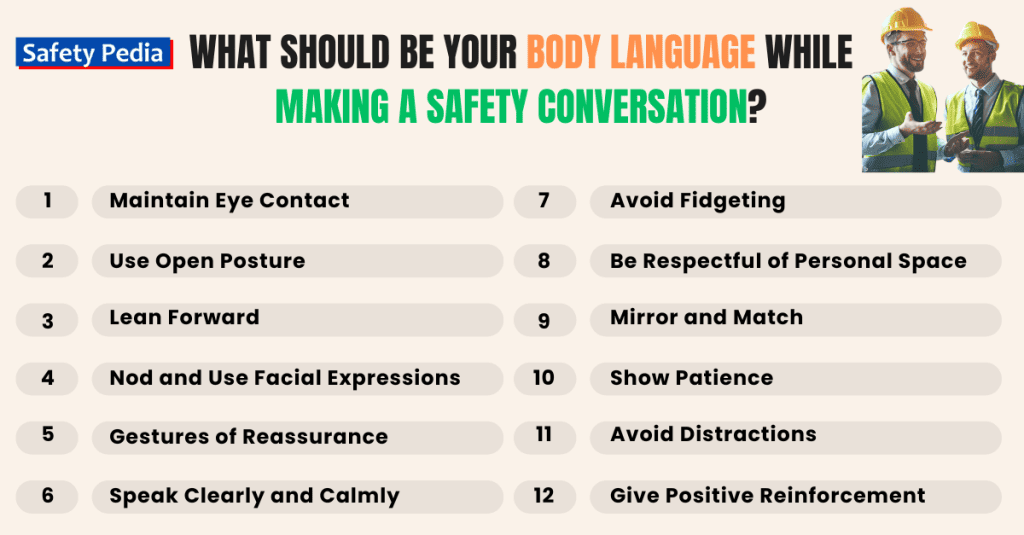
When engaging in a safety conversation, your body language plays a crucial role in conveying sincerity, attentiveness, and empathy. Here are some essential tips for displaying appropriate body language during a safety conversation:
1. Maintain Eye Contact: Establish and maintain appropriate eye contact throughout the conversation. It shows that you are attentive and actively listening to the other person’s concerns or observations about safety.
2. Use Open Posture: Stand or sit with an open posture, avoiding crossed arms or closed-off body language. An open stance signals approachability and willingness to engage in the discussion.
3. Lean Forward: Leaning slightly forward demonstrates interest and engagement in what the other person is saying. It conveys that their safety concerns are important to you.
4. Nod and Use Facial Expressions: Nod occasionally to show that you understand and acknowledge the points being made. Use appropriate facial expressions to convey empathy and concern.
5. Gestures of Reassurance: Employ gestures of reassurance, such as a gentle hand on the shoulder or a supportive pat on the back, if appropriate and culturally acceptable, to show empathy and support.
6. Speak Clearly and Calmly: When speaking, use a clear and calm tone of voice. Avoid raising your voice or becoming confrontational, as it can make the other person defensive or apprehensive.
7. Avoid Fidgeting: Minimize fidgeting or nervous gestures, as they can be distracting and convey a lack of confidence.
8. Be Respectful of Personal Space: Respect the other person’s personal space, as invading it can make them feel uncomfortable or intimidated.
9. Mirror and Match: Subtly mirror the other person’s body language to build rapport and establish a connection. However, be cautious not to mimic excessively, as it may come across as insincere.
10. Show Patience: Allow the person to express their thoughts fully without interrupting. Demonstrate patience and attentiveness to ensure they feel heard and understood.
11. Avoid Distractions: Put away any distracting items, such as phones or papers, to show that the conversation is a priority and that you are fully present.
12. Give Positive Reinforcement: Provide positive reinforcement for the individual’s safety efforts or willingness to raise safety concerns. Encouragement and appreciation can foster a positive safety culture.
How do you stay calm when the other person is spoiling?
Staying calm when dealing with someone upset or behaving poorly can be challenging, but it’s essential to maintain composure and handle the situation constructively. Emotional intelligence is a powerful technique to employ when dealing with someone upset or behaving poorly. Here are some tips on how to stay calm in such circumstances:
1. Self-Awareness: Practice self-awareness by recognizing your own emotional state when faced with a challenging conversation. Be mindful of any signs of frustration or anger, and work on staying composed.
2. Listen Actively: Pay close attention to what the other person is saying, even if their tone or manner is difficult to handle. Active listening demonstrates respect and can help defuse the situation.
3. Empathize: Try to understand the other person’s perspective and emotions. Empathizing with their feelings, even if you disagree with their behavior, can help deescalate tension.
4. Remain Non-Defensive: Avoid becoming defensive or reacting defensively. Stay focused on the issue at hand and avoid taking their behavior personally.
5. Set Boundaries: If the person’s behavior becomes abusive or unacceptable, calmly establish boundaries and let them know that such behavior is unacceptable. Use emotional intelligence to navigate the conversation constructively.
6. Use Calm and Assertive Language: Respond with calm and assertive language. Avoid escalating the situation with aggressive or confrontational speech.
7. Self-Regulation: Use emotional intelligence to regulate your emotions and prevent impulsive reactions. Take deep breaths, count to ten, or mentally step back to regain control over your responses. In my personal opinion Stepping away can allow emotions to settle before resuming the discussion again.
8. Focus on Solutions: Shift the focus from the person’s behavior to finding solutions to the underlying issue. This can redirect the conversation in a more productive direction.
9. Don’t Take It Personally: Remember that the other person’s behavior is a reflection of their emotions or frustrations and may not be a direct attack on you.
10. Stay Mindful of Body Language: Be aware of your own body language and ensure it remains calm and composed. Your nonverbal cues can influence the tone of the conversation.
11. Seek Support: If the situation becomes too challenging to handle alone, consider involving a neutral third party or supervisor to help mediate the conversation.
12. Practice Self-Care: After the interaction, take time to practice self-care and release any built-up tension. Engage in activities that help you relax and recharge.
Staying calm in difficult situations is crucial for maintaining effective communication and resolving conflicts constructively. By staying composed, empathetic, and focused on finding solutions, you can navigate through challenging interactions with greater ease and efficacy.
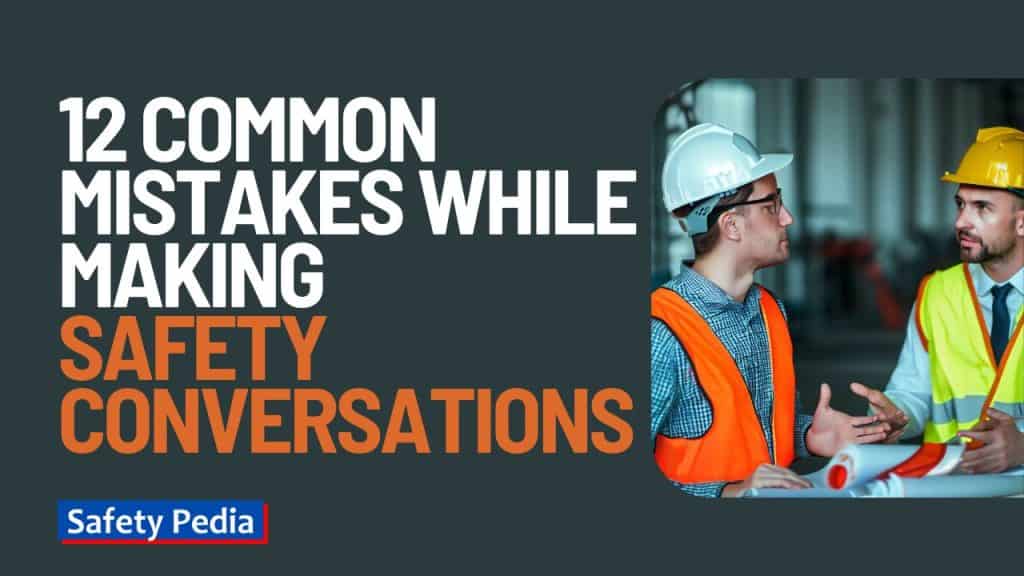
Common Mistakes While Making Safety Conversations
In the context of safety conversations, several common mistakes can hinder communication effectiveness and compromise safety outcomes. These mistakes may arise from various factors, such as miscommunication, lack of awareness, or inadequate training. Recognizing these errors is crucial for safety practitioners to avoid pitfalls and foster more productive and impactful safety discussions. Here are some common mistakes observed in safety conversations:
1. Failure to Listen Actively: A prevalent mistake is a failure to actively listen to the concerns and perspectives of others. Inattentive listening can lead to misunderstandings, overlook critical safety issues, and hinder the establishment of a collaborative safety culture.
2. Relying on Jargon: Overusing technical jargon and complex terminology can alienate participants and impede effective communication. Utilizing language that is easily understood by all stakeholders is essential for clear and concise safety conversations.
3. Neglecting Non-Verbal Cues: Ignoring non-verbal cues, such as body language and facial expressions, can result in missed opportunities to address emotional concerns and unspoken safety issues.
4. Focusing Solely on Compliance: Overemphasizing compliance and regulatory aspects during safety conversations can overshadow a genuine commitment to safety. A balanced approach that includes engagement, understanding, and continuous improvement is essential for a comprehensive safety dialogue.
5. Lack of Empathy: Disregarding the emotional aspect of safety conversations can lead to a disconnect with participants and inhibit the building of trust and rapport. Demonstrating empathy and acknowledging emotions is vital for fostering open and supportive discussions.
6. Blame and Punishment Approach: Adopting a blame-oriented approach can create a culture of fear, where individuals are hesitant to report safety concerns for fear of retribution. Encouraging a blame-free environment promotes transparency and encourages open reporting.
7. Ignoring Feedback: Neglecting to seek feedback from participants and acting on their suggestions can limit the effectiveness of safety conversations. Feedback provides valuable insights for refining safety procedures and communication strategies.
8. Lack of Preparation- Failure to Understand The Scene: Entering safety conversations without adequate preparation can lead to uncertainty, inaccuracies, and missed opportunities to address critical safety issues.
9. Rushing the Conversation: Hasty safety conversations may fail to delve into the underlying causes of safety concerns or overlook essential details, leading to incomplete resolutions.
10. Underestimating Cultural Differences: Disregarding cultural differences and norms can result in misinterpretations and hinder effective safety communication in diverse environments.
11. Neglecting Follow-Up: Failing to follow up on action items and commitments made during safety conversations can erode trust and diminish the impact of safety initiatives.
12. Overlooking Positive Reinforcement: Overemphasis on identifying problems while neglecting to recognize and celebrate safety successes can undermine morale and motivation for ongoing safety improvements.
Conclusion
Effective safety conversations are the backbone of a strong safety culture in the workplace. By implementing these ten techniques, you can foster open communication, empower employees with knowledge, and create a safer working environment. Remember, safety is a shared responsibility, and every conversation about safety brings us one step closer to a workplace free from accidents and injuries. Start implementing these techniques today, and make safety a top priority in your organization.
Reference:
Langill, George, et al. “Working to Promote and Maintain a Safe and Secure Environment in a Hospital Setting.” Healthcare Management Forum, 2000, https://doi.org/10.1016/s0840-4704(10)60781-8.
Help the community to learn safety! You are just a click away from sharing this post.
Related Posts People Also Reading


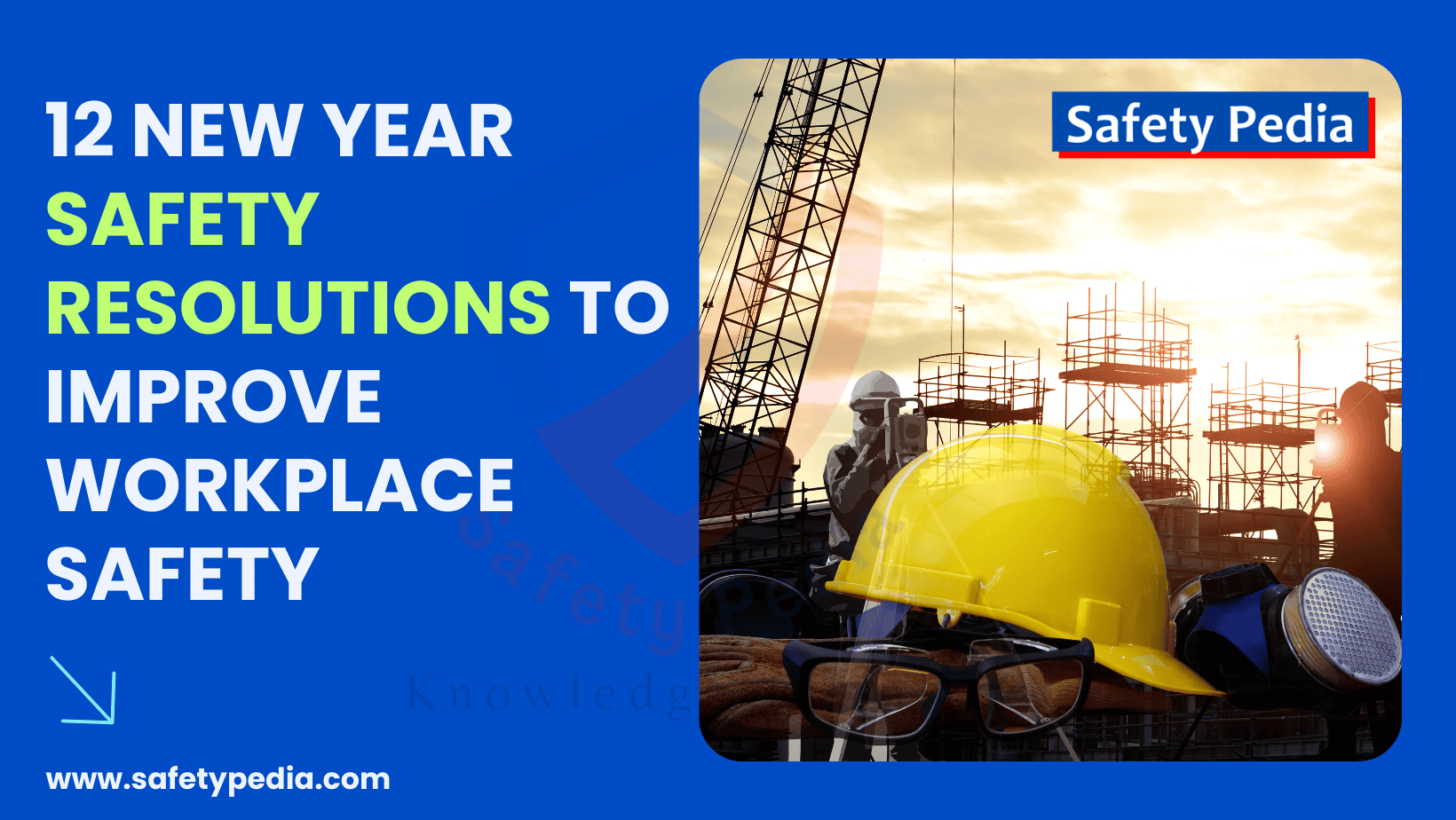
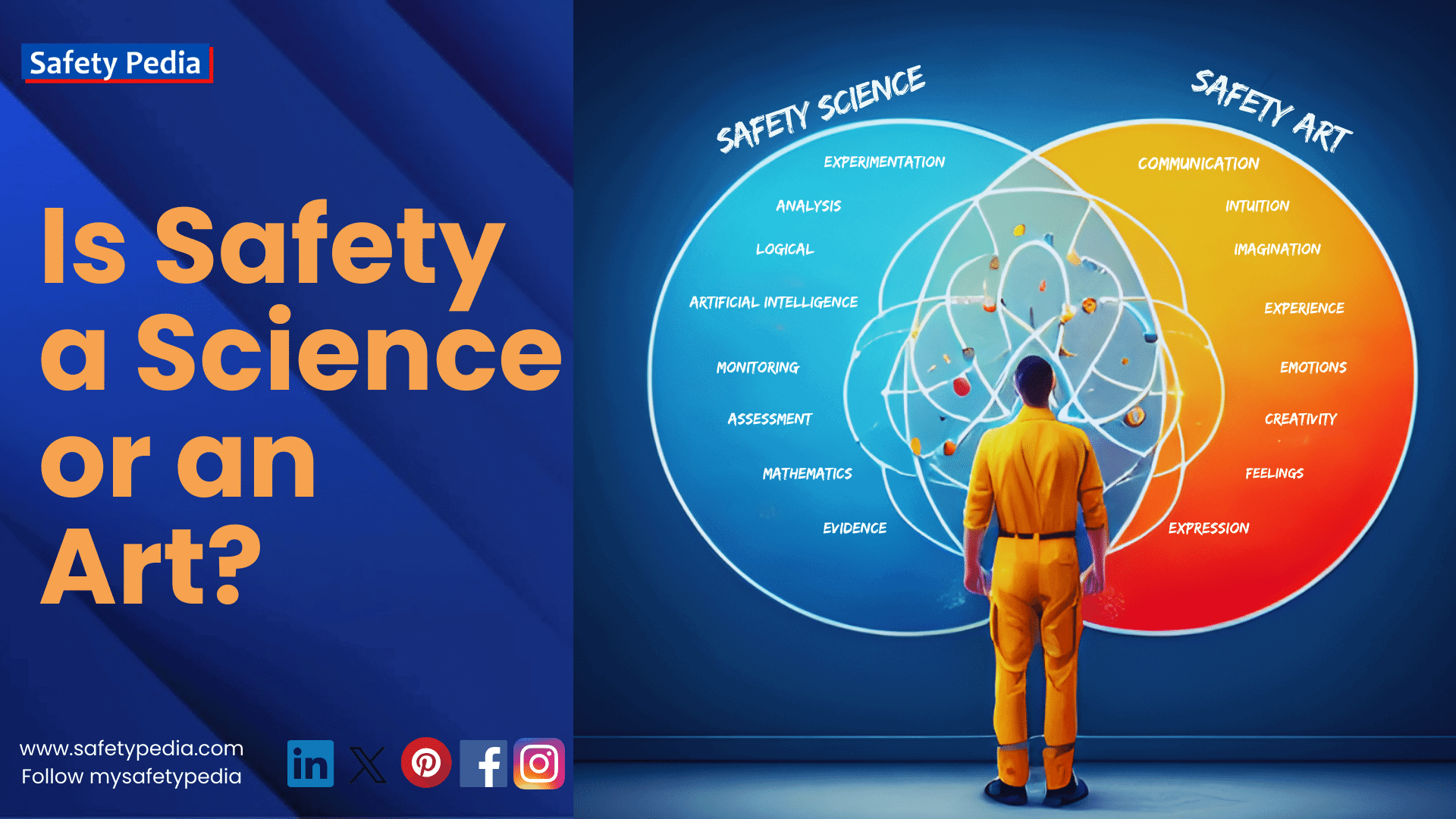




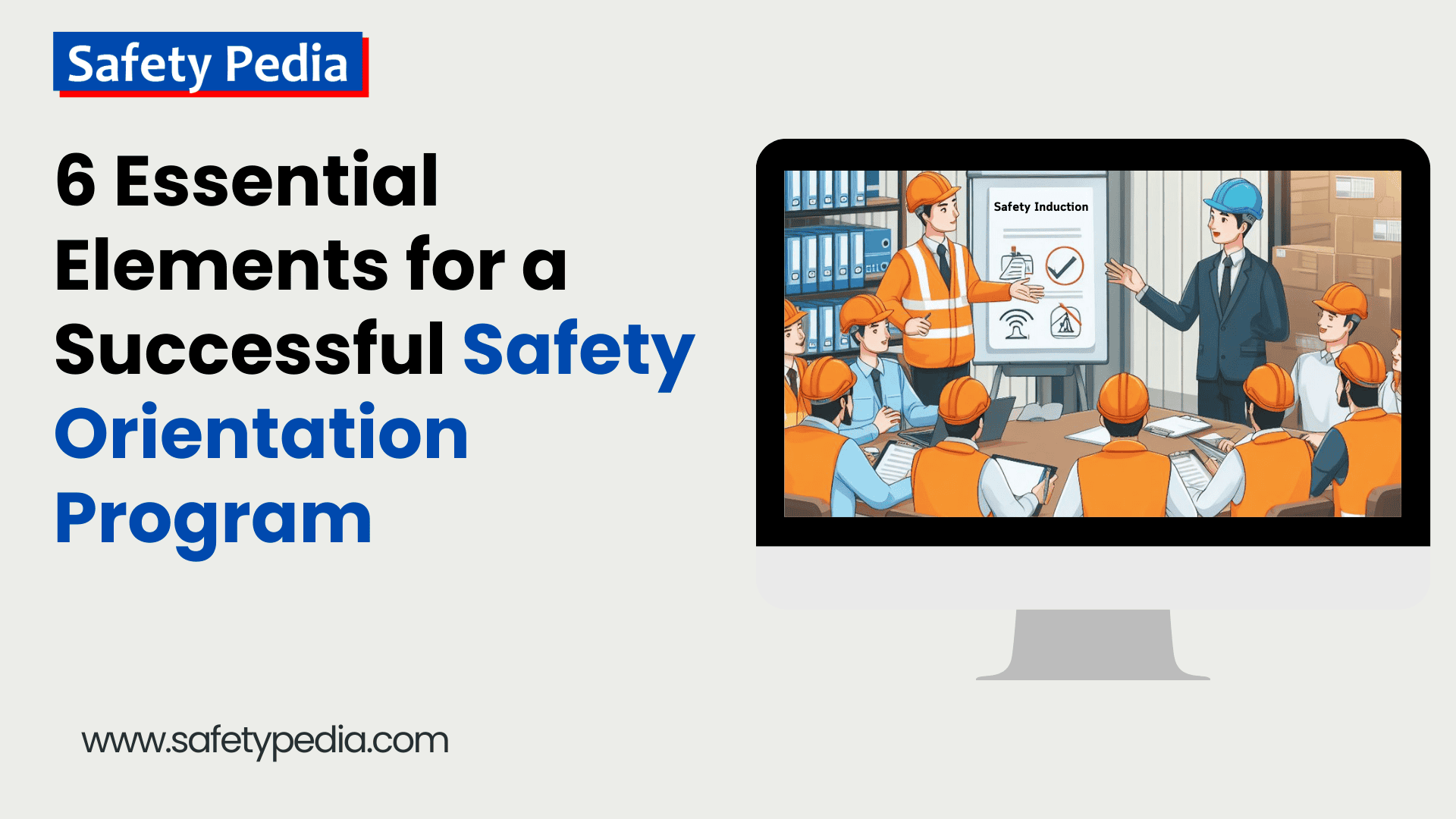
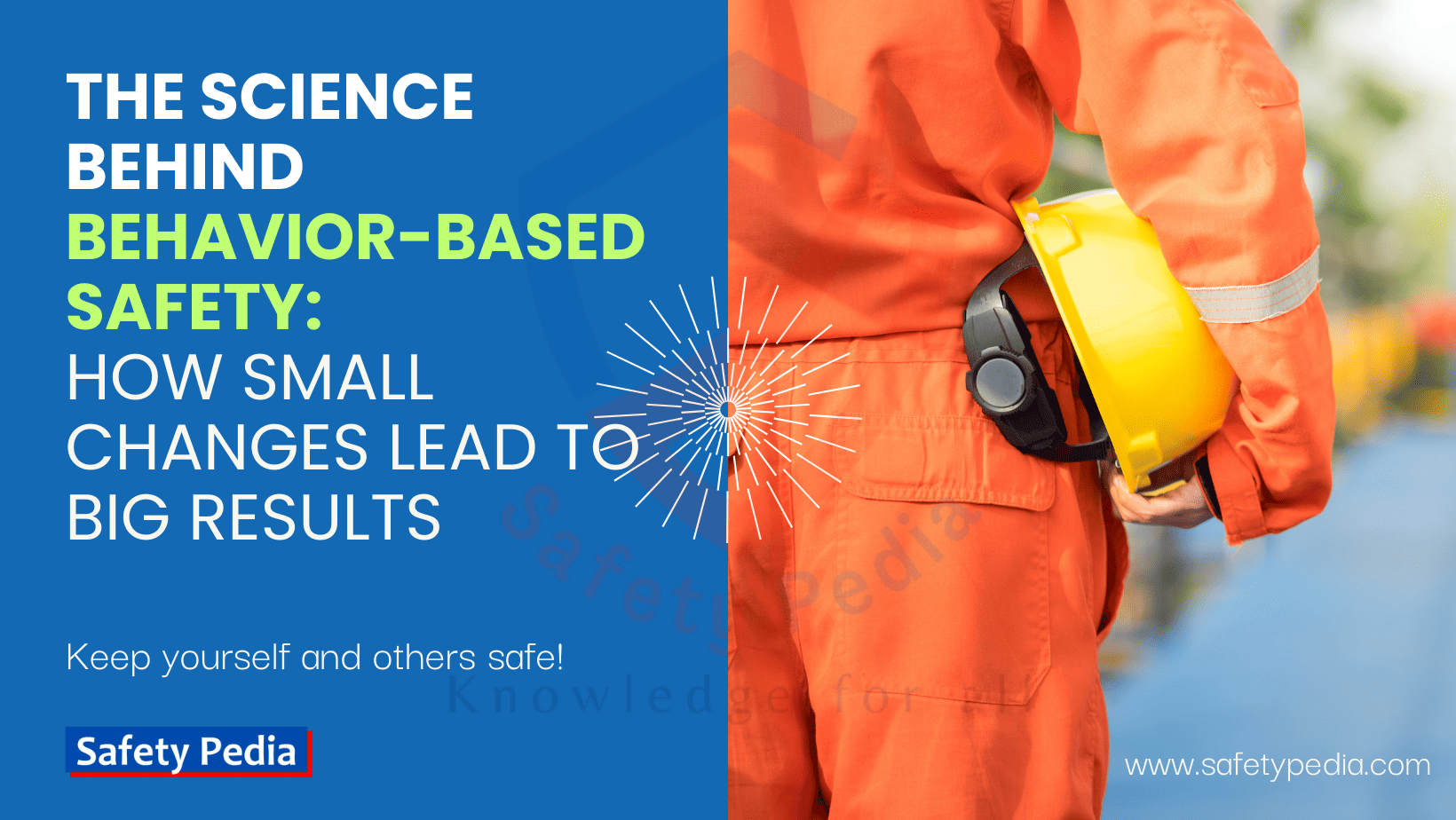
4 thoughts on “12 Effective Safety Conversation Techniques for the Workplace”